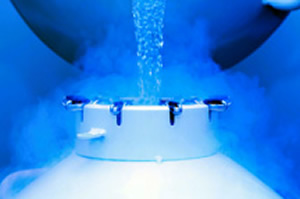 Vitrification vs. Slow Freeze:
Introduction:
There are two basic techniques for cryropreserving
embryos. The first involves a “slow freeze”
process while a second technique uses a more rapid
technique called vitrification. There is published
data suggesting that vitrification may be better with
regards to embryo survival and implantation. This
study was designed to compare the two procedures.
Abstract:
Comparing Cryopreservation
Methods Using Mouse Embryos
Jeremy McGuire, Andrew Bhatnagar, Ph.D. (4/2007)
Innovations in cryopreservation methods have led
to successful cryopreservation of human oocytes
and embryos. The present study was designed to compare
efficacy of two cryopreservation techniques, the
conventional “slow freeze” method and
a new ultra rapid method of “vitrification”.
Previously frozen 2-cell outbred strain of mouse
embryos (BDF X CF1) were thawed and cultured in
vitro in KSOM media for 24 hours to the 6-8 cell
stage and then cryopreserved using 1,2-propanediol
(PROH) as a cryoprotectant for the slow freeze method
and ethylene glycol /dimethyl sulfoxide (EG/DMSO)
for vitrification. Preliminary results suggest that
vitrified embryos exhibited a higher post-thaw survival
rate (100%) and improved blastocyst formation rate
(88%) compared with the slow freeze method (71%
% 59% respectively). Further experiments are in
progress to statically confirm these results and
to evaluate effectiveness of vitrification over
current slow freeze methods for cryopreservation
of human gametes and embryos in clinical IVF laboratories.
Dr. Sweet’s Comments:
This was our first study
using vitrification. The data was intreaging although
not conclusive. Published data regarding human embryos
seems to also be leaning towards vitrification as
a technique that improves the survival rates of
cryopreserved-thawed embryos. The next study we
have proposed involves human oocytes, a much more
difficult cell to freeze, wherein we intend to compare
two different storage containers with respect to
embryologist satisfaction, survival and implantation
rates. Stay tuned!
|






